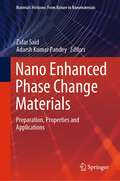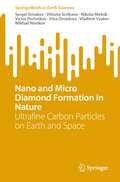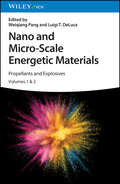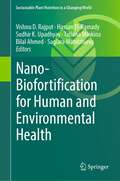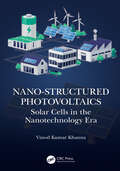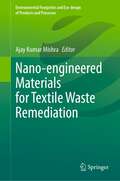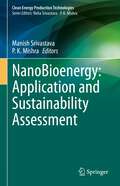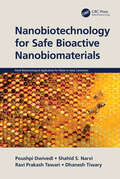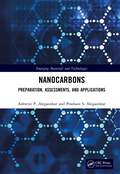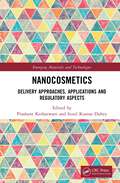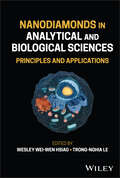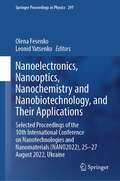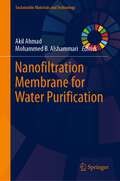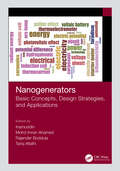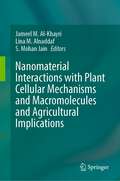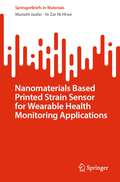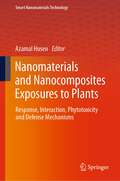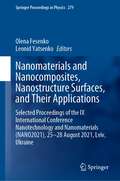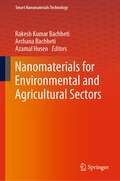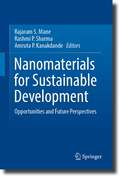- Table View
- List View
Nano Drug Delivery for Cancer Therapy: Principles and Practices
by Firdos Alam KhanThis book discusses the various modes and methods of nano-based drug delivery in different types of cancers such as colon, breast, cervical, ovarian, and lung cancer. It reviews the significance of nano drug delivery in cancer therapy, the application of nanoparticles in overcoming drug resistance, targeted therapy, and immunotherapy. The book also covers topics related to the synthesis of different types, shapes, and sizes of nanocarriers using synthetic and biological approaches. Further, a chapter explores the synthesis of nanocarriers loaded with anti-cancer drugs by using functionalization or conjugations and encapsulation methods. The book also examines the nanocarriers as delivery vehicles for chemotherapeutic agents against cancers using in vitro and animal models of cancers, preclinical trials for efficacy, and safety profiling of nanocarriers. Finally, future trends and innovation in nano drug delivery for cancer therapy, application of siRNA (nanoparticle-based RNA) therapy, ultrasound-linked nano-cancer therapeutics, and application of exosome-based cancer therapy topics are discussed. Towards the end, the book examines the limitations of nanocarriers, including the cell and tissue toxicity, genotoxicity, and scale-up of nanomaterials, health and environmental hazards associated with nanoformulation synthesis, respiratory diseases, government regulations, and ethical issues.
Nano Enhanced Phase Change Materials: Preparation, Properties and Applications (Materials Horizons: From Nature to Nanomaterials)
by Adarsh Kumar Pandey Zafar SaidThis book provides information on thermal energy storage systems incorporating phase change materials (PCMs) which are widely preferred owing to their immense energy storage capacity. The thermal energy storage (TES) potential of PCMs has been deeply explored for a wide range of applications, including solar/electrothermal energy storage, waste heat storage, and utilization, building energy-saving, and thermal regulations. The inherent shortcomings like leakage during phase transition and poor thermal conductivity hamper their extensive usage. Nevertheless, it has been addressed by their shape stabilization with porous materials and dispersing highly conductive nanoparticles. Nanoparticles suspended in traditional phase change materials enhance the thermal conductivity. The addition of these nanoparticles to the conventional PCM enhances the storage. In this book, the history of Nano Enhanced Phase Change Materials (NEPCM), preparation techniques, properties, theoretical modeling and correlations, and the effect of all these factors on the potential applications such as: solar energy, electronics cooling, heat exchangers, building, battery thermal management, thermal energy storage are discussed in detail. Future challenges and future work scope have been included. The information from this book can enable the readers to come up with novel techniques, resolve existing research limitations, and come up with novel NEPCM, that can be implemented for various applications.
Nano Metal Oxides: Engineering and Biomedical Applications
by B. Karthikeyan G. Gnanakumar A. Therasa AlphonsaThis book highlights theoretical and experimental facts about selective nano-metal oxides. TiO2 ,ZnO and transition metal oxides which are known to be semiconductors and find applications in various fields. This book presents about recent findings like photo catalysis, sensing ,coating and biomedical applications. Therapeutic and future applications that are recently been reported of various metal oxides are presented in this book.
Nano and Micro Diamond Formation in Nature: Ultrafine Carbon Particles on Earth and Space (SpringerBriefs in Earth Sciences)
by Sergei Simakov Vittorio Scribano Nikolai Melnik Victor Pechnikov Irina Drozdova Vladimir Vyalov Mikhail NovikovIn this book, readers will gain a deep understanding of the distinct characteristics and intricate formation mechanisms behind each type of diamond.A standout feature of this book is its in-depth exploration of nanodiamonds, shedding light on their unique formation processes. The narrative is thoughtfully organized, covering four main categories of natural diamonds and their related formation processes: 1)Interstellar nanodiamond particles; 2) Nano- and microcrustal diamonds associated with coals, sediments, and metamorphic rocks; 3) Nanodiamonds and microdiamonds associated with secondary alterations of mafic and ultramafic rocks mainly in the oceanic lithosphere; 4) Mantle-derived diamonds associated with kimberlites and their xenoliths, such as peridotites and eclogites.With clarity and precision, this book caters to both researchers and students in the fields of mineralogy and mineral formation. This book serves as an invaluable resource, offering an all-encompassing perspective on diamond formation, appealing to those curious minds eager to delve into the captivating realm of these precious gems.
Nano and Micro-Scale Energetic Materials: Propellants and Explosives
by Luigi T. DeLuca Weiqiang PangProvides an up-to-date account of innovative energetic materials and their potential applications in space propulsion and high explosives Most explosives and propellants currently use a small number of ingredients, such as TNT and nitrocellulose. In comparison to conventional materials, nano- and micro-scale energetic materials exhibit superior burning characteristics and much higher energy densities and explosive yields. Nano and Micro-scale Energetic Materials: Propellants and Explosives provides a timely overview of innovative nano-scale energetic materials (nEMs) and microscale energetic materials (µEMs) technology. Covering nEMs and µEMs ingredients as well as formulations, this comprehensive volume examines the preparation, characterization, ignition, combustion, and performance of energetic materials in various applications of propellants and explosives. Twenty-two chapters explore metal-based pyrotechnic nanocomposites, solid and hybrid rocket propulsion, solid fuels for in-space and power, the sensitivity and mechanical properties of explosives, new energetic materials, and more. Explores novel energetic materials and their potential for use in propellants and explosives Summarizes the most recent advances of leading research groups currently active in twelve countries Discusses how new environmentally friendly, high-combustion energetic materials can best be used in different applications Explains the fundamentals of energetic materials, including similarities and differences between composite propellants and explosives Nano and Micro-scale Energetic Materials: Propellants and Explosives is an important resource for materials scientists, explosives specialists, pyrotechnicians, environmental chemists, polymer chemists, physical chemists, aerospace physicians, and aerospace engineers working in both academia and industry.
Nano- and Microfabrication Techniques in Drug Delivery: Recent Developments and Future Prospects (Advanced Clinical Pharmacy - Research, Development and Practical Applications #2)
by Dimitrios LamprouNew materials and manufacturing techniques are evolving with the potential to address the challenges associated with the manufacture of medicinal products that will teach new tricks to old drugs. Nano- and microfabrication techniques include manufacturing methods such as additive manufacturing, lithography, micro-moulding, spray drying, and supercritical fluids among many others. The increasing resolution of new techniques allow researchers to produce objects with micrometric resolutions. This book follows a consecutive order, beginning with a background in the current field and limitations in the manufacturing of different pharmaceutical products, moving on the classification of each method by providing recent examples, and future prospective on a variety of traditional and new Nano and microfabrication techniques. A focus on the materials used to prepare these systems and their biocompatibility, including applied topics such as clinical applications and regulatory aspects also covered, offering the reader a holistic view of this rapidly growing field.
Nano-Biofortification for Human and Environmental Health (Sustainable Plant Nutrition in a Changing World)
by Hassan El-Ramady Vishnu D. Rajput Tatiana Minkina Sudhir K. Upadhyay Bilal Ahmed Saglara MandzhievaNanotechnology has shown great potential to alleviate increasing pressure to meet food needs for our increasing human population, Novel agricultural innovations are required to enhance the health of edible crops and per unit area yield without impacting the associated environment in a negative way. Recent advancements in nanotechnology-based agricultural solutions have proven to help overcome the problems in agriculture that are associated with run-off of essential fertilizers from agricultural soils, low nutrient accumulation by crops, as well as to control insects, pests, and seasonal biotic factors, treatment of wastewater used for irrigation, plant uptake of xenobiotics (heavy metals, pesticides, industrial chemicals, drugs, and so on) that may be present in contaminated soils. Additionally, the consumption of such food crops may result in malnourishment and plant-mediated transfer of toxic substances among humans especially in underprivileged and rural populations. Agents to stimulate plant growth include various types of nanomaterials such as carbon nanotubes, metal, and metal-oxide nanoparticles. Applications of particular nutrients or elements in crop plants can be shown to aid human nourishment (either by directly inducing its uptake or indirectly through enhancing the intracellular levels of other associated elements that ultimately boost the synthesis of the desired nutrient in plants). It is also important to consider the competence and fate of nanomaterials in soil ecosystems. The entry route of nanomaterials into the environment includes both natural and anthropogenic sources. In order to achieve sustainable and safe use of nanotechnological products in agriculture, similar environmental conditions must be simulated on lab scale with the careful selection of organisms related to agriculture. Thus, emphasis should be placed on the judicial use of nano-enabled products without compromising the sustainability of the environment and human health. This comprehensive book highlights recent field research as well as contributions from academicians in the lab. This book addresses the major aspects related to nanotechnology, biofortification of crops, and human and environmental health.
Nano-Structured Photovoltaics: Solar Cells in the Nanotechnology Era
by Vinod Kumar KhannaPresenting a comprehensive overview of a rapidly burgeoning field blending solar cell technology with nanotechnology, the book covers topics such as solar cell basics, nanotechnology fundamentals, nanocrystalline silicon-based solar cells, nanotextured-surface solar cells, plasmon-enhanced solar cells, optically-improved nanoengineered solar cells, dye-sensitized solar cells, 2D perovskite and 2D/3D multidimensional perovskite solar cells, carbonaceous nanomaterial-based solar cells, quantum well solar cells, nanowire solar cells and quantum dot solar cells. The book provides an in-depth and lucid presentation of the subject matter in an elegant, easy-to-understand writing style, starting from basic knowledge through principles of operation and fabrication of devices to advanced research levels encompassing the recent breakthroughs and cutting-edge innovations. It will be useful for graduate and PhD students, scientists, and engineers.
Nano-engineered Materials for Textile Waste Remediation (Environmental Footprints and Eco-design of Products and Processes)
by Ajay Kumar MishraThis book presents a complete state of the art for different types of nanomaterial, their environmental fate, and their use in textile waste remediation. Nano-engineered materials including nanoparticles, nanofibers, nanotubes have been used extensively for a variety of applications. Environmental concerns have been noted mainly due to the discharge of textile waste. Nanotechnology is fast growing on research and bringing sustainable solution in minimizing the waste. This also minimizes the risk of exposure and health hazards. With the development of industry, environmental pollution and energy shortage have raised awareness of a potential global crisis. So, it is urgent to develop a simple and effective method to address these current issues. Nano-engineered materials can be better solution in finding solution of environmental sustainability more specific to the textile waste remediation. Nano-engineered materials have emerged as pioneering photocatalysts and account for most of the current research in this area. This can provide large surface areas, diverse morphologies, abundant surface states, and easy device modeling, all of which are properties beneficial to photodegradation. Furthermore, the stability and cost of nano-engineered materials are critical factors. Therefore, it is a challenge of great importance to identify and design nano-engineered materials that are efficient, stable, and abundant for the remediation of textile waste.
NanoBioenergy: Application and Sustainability Assessment (Clean Energy Production Technologies)
by P. K. Mishra Manish SrivastavaThis contributed volume presents new insight into sustainable possibilities of combination of nanomaterial and bioenergy production together. Biofuels as renewable energy sources have tremendous potential to replace fossil fuels in future energy scenario as biofuels production is likely to be advanced and novel research areas offers green alternative energy sources. continuous efforts are being made for the cost-effective production of biofuels worldwide to balance its techno-economy. In series of tremendous effort to improve biofuels production technologies, use of nanomaterials to improve biofuels production efficiency is highly emerging area with full scope to developed low cost, rapid technologies for biofuels production. The book covers the practical utility based properties of nanomaterial and bioenergy production together. It also discusses the recent advancements on various nanomaterial utility in biofuel production process along with its low cost application. It covers mega audiences, which include academician, researchers, and industries people. This book will be highly interesting for researchers and scientists as well as related industries.
Nanobiotechnology for Safe Bioactive Nanobiomaterials (Novel Biotechnological Applications for Waste to Value Conversion)
by Dhanesh Tiwary Poushpi Dwivedi Shahid S. Narvi Ravi Prakash TewariThis book begins with an introduction of nanobiotechnology, followed by biosyntheses of AgNPs, development of silver/chitosan (Ag/CS) polymer nanocomposites, synthesis of silver/chitosan-g-poly acrylamide (Ag/CS-g-PAAm) nanocomposite hydrogel and silver/chitosan/poly vinyl chloride (Ag/CS/PVC) blend. Finally, it presents novel bioengineering of polyfunctional metallic nanostructures other than Ag, emphasizing biomass utilization and value-added conversion over an extended span, including life cycle assessment of the synthesized nanostructures. Features: Includes prospective cost effective, eco-friendly, and safe nanomaterials, synthesized through facile paths Covers the synergistic effect of phytochemicals and nano-Ag antimicrobial agents from an antiviral perspective Includes surface coating systems and super absorbent materials for biomedical purposes Examines nanobiotechnological applications for generating nanoalloys with synchronized nanostructural arrangement of alkaline earth metals and nanoscale dots of transition metals Explores the life cycle assessment of synthesized nanomaterials This book aims at researchers and graduate students in biomaterials, chemical engineering, green chemistry, nanomaterials, and biotechnology.
Nanocarbons: Preparation, Assessments, and Applications (Emerging Materials and Technologies)
by Ashwini P. Alegaonkar Prashant S. AlegaonkarThis book provides a practical platform to the readers for facile preparation of various forms of carbon in its nano-format, investigates their structure–property relationship, and finally, realizes them for a variety of applications taking the route of application engineering. It covers the preparation and evaluation of nanocarbons, variety of carbon nanotubes, graphene, graphite, additively manufactured 3D carbon fibres, their properties, and various factors associated with them. A summary and outlook of the nanocarbon field is included in the appendices. Features: Presents comprehensive information on nanocarbon synthesis and properties and some specific applications Covers the growth of carbon nanoparticles, nanotubes, ribbons, graphene, graphene derivatives, porous/spongy phases, graphite, and 3D carbon fabrics Documents a large variety of characterizations and evaluations on the nature of growth causing effect on structure properties Contains dedicated chapters on miniaturized, flat, and 2D devices Discusses a variety of applications from military to public domains, including prevalent topics related to carbon. This book is aimed at researchers and graduate students in materials science and materials engineering, and physics.
Nanocosmetics Delivery Approaches, Applications and Regulatory Aspects: Delivery Approaches, Applications And Regulatory Aspects (Emerging Materials and Technologies)
by Prashant Kesharwani Sunil Kumar DubeyThis book offers an overview of the science of cosmetics and the formulation of nanosized cosmetic products including fabrication, characterization of nanocosmetics, major challenges in the safe applications, regulatory aspects, and commercialization on a large scale. The chapters provide understanding of the interaction of nanocarriers with skin and hair, different nanocosmetic products in the present situation, applications as well as disadvantageous toxicity associated with nanocosmetics, regulatory prospects, and future perspectives. Features: Provide an explicit account on vital aspects of various nanocosmetics drug delivery approaches, thereby providing a next-generation cosmetic product. Bring together the novel applications of nanocosmetics approaches in the biological milieu. Explores preparation, applications, toxicity, and regulatory prospects. Includes a dedicated chapter on Niosomal drug-delivery systems in cosmetics. Discusses the perspectives of the technologies explored so far based upon the findings outlined in highly organized tables, illustrative figures, and flow charts. This book is aimed at researchers and professionals in nanomedicine, pharmaceuticals, biotechnology, and the health sector.
Nanodiamonds in Analytical and Biological Sciences: Principles and Applications
by Wesley Wei-Wen Hsiao Trong-Nghia LeNANODIAMONDS IN ANALYTICAL AND BIOLOGICAL SCIENCES Comprehensive resource highlighting the significance and applications of fluorescent and non-fluorescent nanodiamonds in various domains Nanodiamonds in Analytical and Biological Sciences combines the disciplines of chemistry, physics, materials science, and biology to demonstrate the significance of nanodiamonds, offering precise analysis of the impacts and up-to-date applications of fluorescent and non-fluorescent nanodiamonds, including in COVID-19 and artificial intelligence, with illustrations, case studies, practical examples, and novel perspectives included throughout. Edited by two highly qualified scholars with significant experience in the field, topics covered include: Fundamental properties, synthesis, mechanisms, and functionalization of nanodiamonds, and toxicity assessment Fabrication and surface modification of fluorescent nanodiamonds and in vitro and in vivo bioimaging of fluorescent nanodiamonds Nanodiamond-enabled drug delivery and nanodiamond for mass spectrometry-based analysis of peptides, proteins, and proteomes Quantum sensing, applications in physico-chemical and biomedical sensing, and perspective and outlook on the future of nanodiamond research Nano-scale thermometry of fluorescent nanodiamonds and nanodiamond-enabled drug delivery Offering a balanced, multidisciplinary, and comprehensive overview of the significance of fluorescent and non-fluorescent nanodiamonds, Nanodiamonds in Analytical and Biological Sciences is an essential resource for academic researchers and industry professionals working in fields spanning chemistry, physics, materials science and biology.
Nanoelectronics, Nanooptics, Nanochemistry and Nanobiotechnology, and Their Applications: Selected Proceedings of the 10th International Conference on Nanotechnologies and Nanomaterials (NANO2022), 25–27 August 2022, Ukraine (Springer Proceedings in Physics #297)
by Leonid Yatsenko Olena FesenkoThis book highlights some of the latest advances in nanotechnology and nanomaterials from leading researchers in Ukraine, Europe and beyond. It features contributions presented at the 10th International Science and Practice Conference Nanotechnology and Nanomaterials (NANO2022), which was held on August 25-27, 2022 at Lviv House of Scientists, and was jointly organized by the Institute of Physics of the National Academy of Sciences of Ukraine, University of Tartu (Estonia), University of Turin (Italy), and Pierre and Marie Curie University (France). Internationally recognized experts from a wide range of universities and research institutions share their knowledge and key findings across diverse areas ranging from quantum optics and nanoelectonics to biophysics.The book will be interesting for leading scientists, advanced undergraduate and graduate students in nanoelectronics, optics, bio-and chemical engineering. This book’s companion volume also addresses topics such as nanostructured surface, nanomaterials, and its applications.
Nanofiltration Membrane for Water Purification (Sustainable Materials and Technology)
by Akil Ahmad Mohammed B. AlshammariThis book covers the basic and sustainable approach of nanofiltration membrane techniques along with their fabrication, characterization, separation mechanisms, and broad applications in the field of wastewater treatment. It provides a wide knowledge of nanofiltration technique to water purification audience concerning the recent development with various illustrations, methods and results for graduate students, scientists, academicians, researchers, and industrialists. Readers from wastewater and water purification will have a quick reference by exploring the research literature on the subject field with commercial value-added research applications of nanofiltration membrane.
Nanofluids for Heat Exchangers
by Abdul Wahab Hafiz Muhammad Ali Ali HassanThis book describes the importance of heat transfer in heat exchangers, and fluids properties play a vital role to increase heat transfer rate translating the size of the equipment and cuts in the capital and running cost in the long term. Nanofluids applications in heat exchangers will help to improve the thermophysical properties of the fluid and therefore heat transfer. And, this book explains the enhancing mechanisms of heat transfer by employing nanofluids in heat exchangers. A critical discussion will enable to estimate the pros and cons of such fluids in different types of heat exchangers. Prevailing working conditions for short- and long-term implementation of various types of nanofluids will be discussed and introduced to the readers. This book helps the researchers, scientist and academicians working in the domain to be able to get a comprehensive knowledge at one place regarding the preparation, properties, measurements, data reduction, characteristics and applications of nanofluids in heat exchangers.
Nanogenerators: Basic Concepts, Design Strategies, and Applications
by InamuddinThis book provides an in-depth review of the history, fundamental theory, design strategies, and applications of nanogenerators. Working principles, device mechanisms, material characteristics, types of nanogenerators, and their different uses are fully explored.Top researchers in the field of sustainable technology from different backgrounds and fields contribute their expertise to deliver a must-have practical resource for students, academic researchers, and industry professionals.FEATURES Describes the fundamental aspects and theory of nanogenerators Explores design strategies including material assessment based upon planned application Tailors the introduction and essential concept discussion for the industrial and research community Explores current applications, existing challenges, and the future outlook for the field
Nanohybrid Materials for Treatment of Textiles Dyes (Smart Nanomaterials Technology)
by Mohammad Jawaid Akil Ahmad Mohamad Nasir Mohamad Ibrahim Asim Ali Yaqoob Mohammed B. AlshammariThis book covers the various aspects of nanohybrid materials and its composites for their application in treatment of toxic textiles dyes for cleaning the environment especially water and wastewater. The book first looks into the various preparation and characterization techniques for nanohybrid materials. The replacement of other conventional materials with highly efficient (high surface area, pore size, and chemical and mechanical strength) nanohybrid materials and their application in the field of environmental purification through treatment of textile dyes is highlighted in the later part of the book. The book caters to students, researchers, and scientists who are working in the field of wastewater treatment for incorporating novel materials to remove toxic textile dyes from contaminated wastewater.
Nanomaterial Interactions with Plant Cellular Mechanisms and Macromolecules and Agricultural Implications
by S. Mohan Jain Jameel M. Al-Khayri Lina M. AlnaddafThis book focuses on the recent progress of nanotechnology with emphasis on the interaction between nanoparticles and plants on the cellular level. It is devoted to understanding the pathways of nanomaterials entry into plant cell and their influence on cellular organelle processes and influence on crop yield. It consists of 16 chapters grouped in 3 parts: Part I Cellular mechanisms, Part II Cellular macromolecules, and Part III Implications of nanomaterials. Chapters present the plant response to nanomaterial applications including morphological, physiochemical, and anatomical changes and their effect on plant growth and productivity. The book discusses the mechanisms of absorbance and translocation of nanoparticles and their interaction with the plant cellular biochemical compounds and organelles. It presents the current perspective of nanomaterials influence on cellular processes which include photosynthesis, photorespiration and pigment synthesis and accumulation. In addition, it provides current understanding of the impact of nanomaterials on cellular macromolecules including carbohydrates, lipids, nucleic acids, proteins, hormones, and antioxidant defense activities. Collectively, these processes and biochemical compounds have implications on crop yield. Chapters are written by globally recognized scientists and subjected to a rigorous review process to ensure quality presentation and scientific precision. Chapter begins with an introduction that covers similar contexts and includes a detailed discussion of the topic accompanied by high-quality color images, diagrams, and relevant details and concludes with recommendations for future study directions.Chapter "Impact of Nanomaterials on Plant Secondary Metabolism" is available open access under a Creative Commons Attribution 4.0 International License via link.springer.com.
Nanomaterials Based Printed Strain Sensor for Wearable Health Monitoring Applications (SpringerBriefs in Materials)
by Mariatti Jaafar Ye Zar Ni HtweThis book reviews different types of nanomaterials-based-conductive inks used to develop printed strain sensors, printing fabrication methods, and applications such as wearable health monitoring. Printed wearable electronic devices have recently drawn a lot of attention, as shown by the increasing number of publications and commercialized devices covering various facets in emerging fields. Many researchers are working toward optimizing nanoparticle-based-conductive inks for wearable electronics. However, issues related to its stability, dispersion, and annealing temperature often limit its applications. General important information and requirements of flexible electronics for health monitoring are covered in the book chapter. The target audiences are researchers and students who are involved in the development of printed wearable electronics.
Nanomaterials and Nanocomposites Exposures to Plants: Response, Interaction, Phytotoxicity and Defense Mechanisms (Smart Nanomaterials Technology)
by Azamal HusenThis book looks at the interaction between plants and nanomaterials/nanocomposites, and their effects ecology, the food chain and human health. It focuses on nanomaterials/nanocomposites phytotoxicity, which is an important precondition to promote the application of nanotechnology and to avoid the potential ecological risks. It describes the influencing factors of nanotoxicity of nanomaterials and the mechanisms of these toxic effects and defense mechanisms in plants. The chapters in this book are written by internationally renowned researchers and professionals and provides exciting and remarkable information (on the above-mentioned topics) to the scientist, researcher and student working field of plant biology, agricultural science, nanobiotechnology, plant biochemistry, plant physiology, plant biotechnology and many other interdisciplinary subjects.
Nanomaterials and Nanocomposites, Nanostructure Surfaces, and Their Applications: Selected Proceedings of the IX International Conference Nanotechnology and Nanomaterials (NANO2021), 25–28 August 2021, Lviv, Ukraine (Springer Proceedings in Physics #279)
by Leonid Yatsenko Olena FesenkoThis book highlights some of the latest advances in nanotechnology and nanomaterials from leading researchers in Ukraine, Europe and beyond. It features contributions presented at the 8th International Science and Practice Conference Nanotechnology and Nanomaterials (NANO2020), which was held on August 25–28, 2021 at Lviv Polytechnic National University, and was jointly organized by the Institute of Physics, the National Academy of Sciences of Ukraine, Lviv Polytechnic National University, University of Tartu (Estonia), University of Turin (Italy), Pierre and Marie Curie University (France), European Profiles S.A. (Greece), Representation of the Polish Academy of Sciences in Kyiv, University of Angers (France), Ruprecht Karl University of Heidelberg (Germany). Internationally recognized experts from a wide range of universities and research institutions share their knowledge and key findings on material properties, behavior, and synthesis. This book’s companion volume also addresses topics such as nano-optics, energy storage, and biomedical applications.
Nanomaterials for Environmental and Agricultural Sectors (Smart Nanomaterials Technology)
by Azamal Husen Rakesh Kumar Bachheti Archana BachhetiThis book gives a complete overview of current developments in nanotechnology-based environmental remediation and sustainable agriculture practices/sectors. It will provide the use of nanotechnology in the agricultural sector such as crop production and improvement, soil fertility management along with benefits and risks of nanotechnology on ecological farming. Additionally, the book also discovers how nanotechnology is used in water, air remediation techniques and major challenges in using nanomaterials for improving water and air quality. The book can be a reference source for academicians, scientists, policymakers, students, and research scientists working in minimizing the environmental pollution and increasing agricultural production using nanoparticles.
Nanomaterials for Sustainable Development: Opportunities and Future Perspectives
by Rajaram S. Mane Rashmi P. Sharma Amruta P. KanakdandeThis book highlights recent advances in variety of nanomaterials classes including metal chalcogenides, metal oxides/hydroxides, polymer, metal-organic frameworks, and hybrid nanostructures, with a focus on their properties, synthesis methods, and key applications. It also offers detailed coverage on the toxicity aspects with possible solution. Additionally, it provides complete and comprehensive information on surface modification strategies of nanoparticles to achieve desired outcomes. This book discusses potential applications and major challenges of using these nanomaterials in the fields of biomedical sciences, agricultural industry, bioenergy, biofuel production, and environmental remediation, etc. Overall, this book provides crucial background in nanobiotechnology that compliments the understanding of experimental design for the production of more customized nanomaterials to avail desirable benefits.

